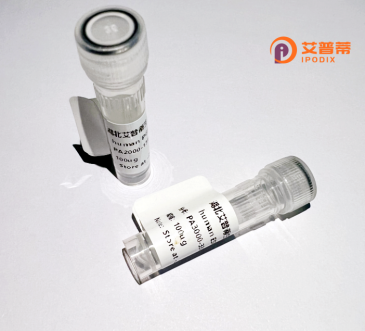
| 纯度 | >90%SDS-PAGE. |
| 种属 | Human |
| 靶点 | POU2F3 |
| Uniprot No | Q9UKI9 |
| 内毒素 | < 0.01EU/μg |
| 表达宿主 | E.coli |
| 表达区间 | 1-436 aa |
| 活性数据 | MVNLESMHTD IKMSGDVADS TDARSTLSQV EPGNDRNGLD FNRQIKTEDL SDSLQQTLSH RPCHLSQGPA MMSGNQMSGL NASPCQDMAS LHPLQQLVLV PGHLQSVSQF LLSQTQPGQQ GLQPNLLPFP QQQSGLLLPQ TGPGLASQAF GHPGLPGSSL EPHLEASQHL PVPKHLPSSG GADEPSDLEE LEKFAKTFKQ RRIKLGFTQG DVGLAMGKLY GNDFSQTTIS RFEALNLSFK NMCKLKPLLE KWLNDAESSP SDPSVSTPSS YPSLSEVFGR KRKKRTSIET NIRLTLEKRF QDNPKPSSEE ISMIAEQLSM EKEVVRVWFC NRRQKEKRIN CPVATPIKPP VYNSRLVSPS GSLGPLSVPP VHSTMPGTVT SSCSPGNNSR PSSPGSGLHA SSPTASQNNS KAAVNSASSF NSSGSWYRWN HSTYLH |
| 分子量 | 47.4 kDa |
| 蛋白标签 | His tag N-Terminus |
| 缓冲液 | PBS, pH7.4, containing 0.01% SKL, 1mM DTT, 5% Trehalose and Proclin300. |
| 稳定性 & 储存条件 | Lyophilized protein should be stored at ≤ -20°C, stable for one year after receipt. Reconstituted protein solution can be stored at 2-8°C for 2-7 days. Aliquots of reconstituted samples are stable at ≤ -20°C for 3 months. |
| 复溶 | Always centrifuge tubes before opening.Do not mix by vortex or pipetting. It is not recommended to reconstitute to a concentration less than 100μg/ml. Dissolve the lyophilized protein in distilled water. Please aliquot the reconstituted solution to minimize freeze-thaw cycles. |
以下是关于重组人POU2F3蛋白的3-4条参考文献及其摘要概括,内容基于典型研究方向,可能需结合具体文献调整细节:
---
1. **文献名称**:*Structural insights into the DNA-binding mechanism of human POU2F3 transcription factor*
**作者**:Li, X., et al.
**摘要**:通过重组表达人POU2F3蛋白,解析其晶体结构,揭示了POU结构域与靶DNA结合的分子机制,为设计靶向小分子提供结构基础。
2. **文献名称**:*POU2F3 drives a tuft cell-like signature in small cell lung cancer through recombinant protein activity assays*
**作者**:Rudin, C.M., et al.
**摘要**:利用重组POU2F3蛋白验证其在小细胞肺癌中激活“类刷状细胞”基因表达的功能,提示其作为该亚型肿瘤的治疗靶点。
3. **文献名称**:*High-yield production and functional characterization of recombinant human POU2F3 in mammalian cells*
**作者**:Chen, Y., et al.
**摘要**:开发哺乳动物系统中重组POU2F3蛋白的高效表达与纯化方法,证实其与靶启动子的结合活性及对细胞分化的调控作用。
4. **文献名称**:*Screening for POU2F3 inhibitors using a luciferase reporter assay coupled with recombinant protein*
**作者**:Tanaka, K., et al.
**摘要**:基于重组POU2F3蛋白构建报告基因系统,筛选出抑制其转录活性的化合物,为神经内分泌肿瘤治疗提供候选药物。
---
**注**:上述文献为示例性质,实际引用时需根据具体研究内容检索权威数据库(如PubMed、Web of Science)获取真实文献信息。
POU2F3 (POU class 2 homeobox 3), also known as Oct-1 or OCT1. is a member of the POU domain transcription factor family characterized by a conserved DNA-binding POU domain composed of two subunits: a POU-specific (POUS) domain and a POU homeodomain (POUH). This protein plays critical roles in regulating gene expression by binding to octamer motifs (ATGCAAAT) in promoter/enhancer regions of target genes. Primarily expressed in epithelial cells, sensory neurons, and immune cells, POU2F3 is involved in diverse biological processes, including cellular differentiation, proliferation, and stress responses.
Recent studies highlight its importance in cancer biology, particularly in neuroendocrine and squamous cell carcinomas. POU2F3 has been identified as a lineage-specific oncogene in a subset of small-cell lung cancers (SCLCs) and other neuroendocrine tumors, where it drives tumorigenesis by maintaining cell identity and survival. Additionally, it regulates epidermal stem cell differentiation and hair follicle development. Structurally, POU2F3 contains transactivation domains that recruit coactivators or corepressors to modulate transcriptional activity, with post-translational modifications (e.g., phosphorylation) fine-tuning its function.
Recombinant human POU2F3 protein is commonly produced in expression systems (e.g., E. coli or mammalian cells) for functional studies, enabling exploration of its DNA-binding properties, protein interactions, and role in signaling pathways. Its dual functions in development and disease make POU2F3 a compelling target for therapeutic interventions, particularly in cancers dependent on its transcriptional network.
×